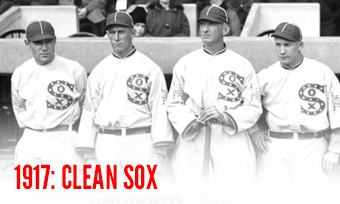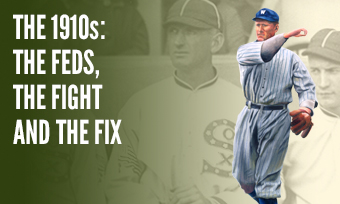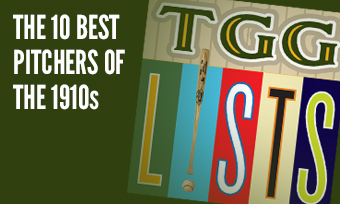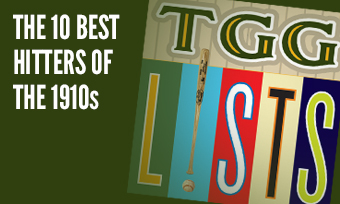The Yearly Reader
Leaders and Honors, 1917
Our list of baseball’s top 10 hitters and pitchers in both the American League and National League for the 1917 baseball season, as well as the awards and honors given to the game’s top achievers of the year.
The National League’s Top 10 Hitters, 1917
Bold type in brick red indicates league leader.
1. Rogers Hornsby, St. Louis
Key Numbers: .327 average, 86 runs, 24 doubles, 17 triples, 8 home runs, 66 RBIs, .484 slugging percentage.
The Rajah’s rise to stardom included a league leading slugging percentage in spite of just eight home runs. He’d lead the NL again in the former department—but with a few more pops.
2. George Burns, New York
Key Numbers: .302 average, 103 runs, 180 hits, 25 doubles, 13 triples, 75 walks, 40 stolen bases.
The consistent Burns, who hit anywhere between .272 and .303 over 11 full-time seasons, gave it a little extra while NL offense in general slumped.
3. Edd Roush, Cincinnati
Key Numbers: .341 average, 82 runs, 178 hits, 14 triples.
Using a 48-ounce bat said to be the heaviest ever in the bigs, Roush won his first NL batting crown.
4. Gavvy Cravath, Philadelphia
Key Numbers: .280 average, 29 doubles, 16 triples, 12 home runs, 83 RBIs, 70 walks.
It must be said: 11 of Cravath’s 12 home runs were hit in two ballparks (Philadelphia’s Baker Bowl and New York’s Polo Grounds) with cozy porches down the lines.
5. Benny Kauff, New York
Key Numbers: .308 average, 89 runs, 172 hits, 68 RBIs, 30 stolen bases.
The Ex-Fed searching for superstardom in the NL came the closest to it in 1917.
6. Heinie Groh, Cincinnati
Key Numbers: 156 games, .304 average, 91 runs, 182 hits, 39 doubles, 11 triples, 71 walks, .385 on-base percentage.
After often just missing the .300 mark in his first four everyday seasons, Groh finally finished above it—as he would do for three of the next four years as well.
7. Max Carey, Pittsburgh
Key Numbers: .296 average, 82 runs, 12 triples, 7 intentional walks, 46 stolen bases, 30 caught stealing.
Though leading off for much of the year, Carey’s 51 RBIs led an otherwise dormant Pirates offense.
8. Heinie Zimmerman, New York
Key Numbers: .297 average, 22 doubles, 9 triples, 5 home runs, 100 RBIs.
Going by Henry as anti-German sentiment swept across wartime America, Zimmerman nevertheless felt at home playing in his birthplace of New York City.
9. Red Smith, Boston
Key Numbers: .295 average, 31 doubles, 2 home runs, 62 RBIs.
After a poor start, Smith kicked it into high gear and nearly hit .300 for the first time in his career.
10. Hal Chase, Cincinnati
Key Numbers: .277 average, 602 at-bats, 28 doubles, 15 triples, 86 RBIs.
The veteran first baseman reportedly began to show that his above numbers could have been better had gambling money not taken a higher priority.
The American League’s Top 10 Hitters, 1917
1. Ty Cobb, Detroit
Key Numbers: .383 average, 588 at-bats, 107 runs, 225 hits, 44 doubles, 24 triples, 6 home runs, 102 RBIs, 55 stolen bases, .444 on-base percentage, .570 slugging percentage.
Perched at or near the top of practically every offensive category, Cobb had one of his most dominant campaigns yet; he became the only major leaguer to have three games with three triples in multiple seasons (also performing the trick in 1911).
2. Tris Speaker, Cleveland
Key Numbers: .352 average, 90 runs, 184 hits, 42 doubles, 11 triples, 67 walks, 7 intentional walks, 30 stolen bases.
Another terrific year for Spoke despite a scary beaning in mid-August that cost him just over a week of play; it might have been far longer had the ball struck him an inch lower, according to the team doctor.
3. Bobby Veach, Detroit
Key Numbers: .319 average, 182 hits, 31 doubles, 12 triples, 110 RBIs, 9 hit-by-pitches.
For no particular reason, Veach hit 100 points higher on the road (.368) than he did at home (.268).
4. Eddie Collins, Chicago
Key Numbers: .289 average, 91 runs, 12 triples, 89 walks, 53 stolen bases.
A rare showing below the .300 mark didn’t keep Collins from remaining one of the AL’s most potent offensive threats.
5. Joe Jackson, Chicago
Key Numbers: .301 average, 91 runs, 20 doubles, 17 triples, 75 walks.
Shoeless Joe had the lowest batting average of his career, but it could have been even worse; he was hitting as low as .261 in mid-August before going on a rampage down the stretch.
6. Ray Chapman, Cleveland
Key Numbers: .302 average, 98 runs, 170 hits, 28 doubles, 13 triples, 52 stolen bases, 22 caught stealing, 67 sacrifice hits.
Growing into his own as a shortstop and leadoff hitter, Chapman gave the Indians a big lift at the top and up the middle—and set a major league mark with 67 sacrifice bunts.
7. Happy Felsch, Chicago
Key Numbers: .308 average, 177 hits, 10 triples, 6 home runs, 99 RBIs.
Even as opposing pitchers quelled White Sox stars Eddie Collins and Joe Jackson (above) to a modest degree of success, they then had to contend with Felsch, who outhit, out-RBI’d and outhomered the other two.
8. Braggo Roth, Cleveland
Key Numbers: .285 average, 30 doubles, 9 triples, 72 RBIs, 73 strikeouts, 51 stolen bases.
Roth stole a career-high 51 bags—six of them at home, just two shy of the all-time mark.
9. George Sisler, St. Louis
Key Numbers: .353 average, 190 hits, 30 doubles, 9 triples, 37 stolen bases.
Were it not for Sisler—who hit some 100 points higher than his teammates—the Browns would have surely landed in the AL cellar.
10. Sam Rice, Washington
Key Numbers: .302 average, 177 hits, 35 stolen bases.
Rice was the latest in a growing trend of future Hall of Famers (Sisler, Babe Ruth) who arrived as hot pitching prospects and emerged as even better hitters.
The National League’s Top 10 Pitchers, 1917
1. Pete Alexander, Philadelphia
Key Numbers: 1.83 ERA, 30 wins, 13 losses, 44 starts, 34 complete games, 8 shutouts, 388 innings, 56 walks, 200 strikeouts.
Alexander finished his salad days at Philadelphia—leading the NL in wins, shutouts and ERA for the third straight year—before reporting to the front lines of the Great War.
2. Ferdie Schupp, New York
Key Numbers: 1.95 ERA, 21 wins, 7 losses, .750 win percentage, 272 innings.
Later wildness would make Schupp’s wonderful 1917 effort stand out like a major spike in his year-by-year ledger.
3. Fred Toney, Cincinnati
Key Numbers: 2.20 ERA, 24 wins, 16 losses, 339.2 innings.
Never more needed with a career-high number of innings, Toney showed he was well-prepped for his 10-inning no-hit victory over fellow no-no contender Hippo Vaughn; he once threw a 17-inning no-hitter in the minors.
4. Fred Anderson, New York
Key Numbers: 1.44 ERA, 8 wins, 8 losses, 38 appearances, 18 starts.
A Federal League refugee who years earlier had quit baseball to take up dentistry, Anderson was all smiles upon returning to the game and stealing away with the NL ERA title.
5. Slim Sallee, New York
Key Numbers: 2.17 ERA, 18 wins, 7 losses, 4 saves.
After struggling to reach .500 with some bad Cardinals teams of the early 1910s, Sallee found victorious bliss from a much more supportive Giants lineup.
6. Hippo Vaughn, Chicago
Key Numbers: 2.01 ERA, 23 wins, 13 losses, 295.2 innings.
Though he didn’t win the one game in which he threw no-hit ball for nine innings (thanks, Fred Toney), Vaughn still managed to rack up enough victories to set a personal mark.
7. Pol Perritt, New York
Key Numbers: 1.88 ERA, 17 wins, 7 losses.
Throwing a career-high 12 innings without conceding an earned run in his last start of the year made Perritt one of three Giants pitchers with a sub-2.00 ERA.
8. Art Nehf, Boston
Key Numbers: 2.16 ERA, 17 wins, 8 losses.
The young southpaw gave signs of good things to come by throwing a Braves franchise-record 41 consecutive scoreless innings toward the end of the season.
9. Eppa Rixey, Philadelphia
Key Numbers: 2.27 ERA, 16 wins, 21 losses, 281.1 innings.
A notorious clubhouse destroyer when he lost, Rixey probably had his teammates scurrying to clear their lockers early, fast and often in 1917 with 21 defeats in spite of a fine ERA.
10. Wilbur Cooper, Pittsburgh
Key Numbers: 2.36 ERA, 17 wins, 11 losses, 297.2 innings.
A sole shining light on a Pirates team that was clearly baseball’s worst; they were 34-92 in games in which he didn’t have a decision.
The American League’s Top 10 Pitchers, 1917
1. Eddie Cicotte, Chicago
Key Numbers: 1.53 ERA, 28 wins, 12 losses, 49 appearances, 346.2 innings.
Cicotte was a long way from the bad ol’ days when the Tigers traded him to a minor league team in exchange for ballpark rent.
2. Stan Coveleski, Cleveland
Key Numbers: 1.81 ERA, 19 wins, 14 losses, 9 shutouts, 298.1 innings.
As the career of older brother Harry began to disintegrate in Detroit, Stan’s took off in Cleveland in his second full season, posting a career-low ERA.
3. Walter Johnson, Washington
Key Numbers: 2.21 ERA, 23 wins, 16 losses, 47 appearances, 8 shutouts, 328 innings, 188 strikeouts, 14 hit-by-pitches.
The Big Train’s ERA finished above 2.00 for the only time in the decade, but he still managed to do all the other things—win games, strike out batters, etc.—and do them quite well.
4. Jim Bagby, Cleveland
Key Numbers: 1.96 ERA, 23 wins, 13 losses, 7 saves, 49 appearances, 320.2 innings.
While Sisler, Ruth and Rice went from pitching to hitting, Bagby went the opposite way—thriving as a screwball pitcher after years toiling as a minor league outfielder.
5. Carl Mays, Boston
Key Numbers: 1.74 ERA, 22 wins, 9 losses, 289 innings, 14 hit-by-pitches.
Known for his penchant of throwing in at hitters—as Ray Chapman would fatally find out in 1920—Mays led the AL in hit batsmen for the only time in his career.
6. Babe Ruth, Boston
Key Numbers: 2.01 ERA, 24 wins, 13 losses, 35 complete games, 326.1 innings.
In his last year as a full-time starting pitcher, Ruth continued to perform as if he would be a cinch for the Hall of Fame based on his exploits on the mound.
7. Reb Russell, Chicago
Key Numbers: 1.95 ERA, 15 wins, 5 losses, .750 win percentage.
Despite being occasionally sidelined from a sore arm—said to be the fault of trying to learn the curve—Russell still looked sharp when healthy.
8. Dutch Leonard, Boston
Key Numbers: 2.17 ERA, 16 wins, 17 losses, 294.1 innings.
Hard-luck season for Leonard, whose sharp ERA was complicated by poor offensive support (less than three runs per start).
9. Hooks Dauss, Detroit
Key Numbers: 2.43 ERA, 17 wins, 14 losses, 270.2 innings.
The eventual 223-game winner threw six of his 22 career shutouts in 1917.
10. Red Faber, Chicago
Key Numbers: 1.92 ERA, 16 wins, 13 losses.
Playing for a championship team with that ERA, you would think Faber would have won more games; he made it up by nailing down three W’s in the World Series.









